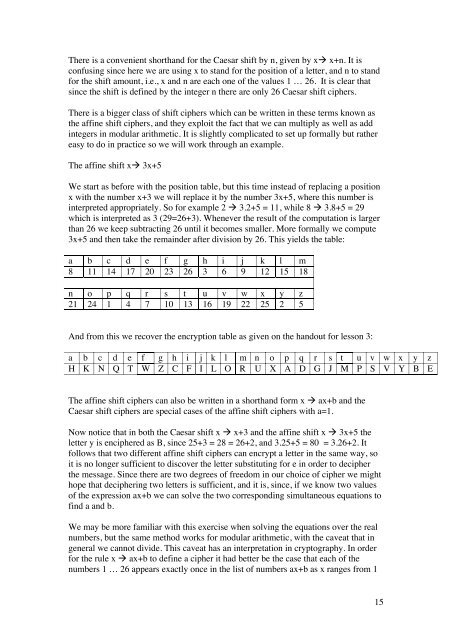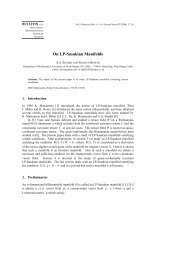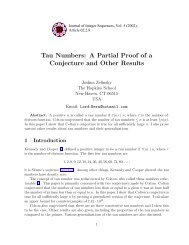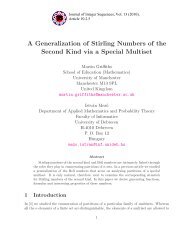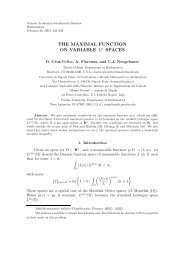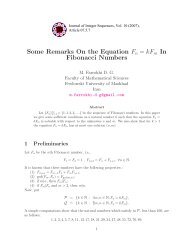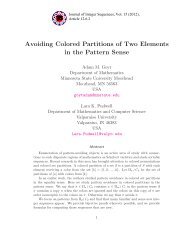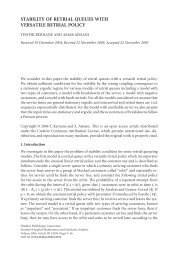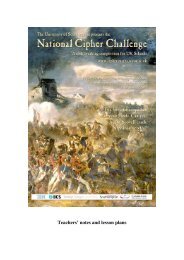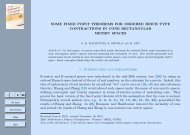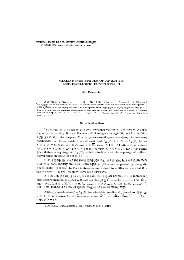Teachers' pack - National Cipher Challenge - University of ...
Teachers' pack - National Cipher Challenge - University of ...
Teachers' pack - National Cipher Challenge - University of ...
You also want an ePaper? Increase the reach of your titles
YUMPU automatically turns print PDFs into web optimized ePapers that Google loves.
There is a convenient shorthand for the Caesar shift by n, given by xà x+n. It isconfusing since here we are using x to stand for the position <strong>of</strong> a letter, and n to standfor the shift amount, i.e., x and n are each one <strong>of</strong> the values 1 … 26. It is clear thatsince the shift is defined by the integer n there are only 26 Caesar shift ciphers.There is a bigger class <strong>of</strong> shift ciphers which can be written in these terms known asthe affine shift ciphers, and they exploit the fact that we can multiply as well as addintegers in modular arithmetic. It is slightly complicated to set up formally but rathereasy to do in practice so we will work through an example.The affine shift xà 3x+5We start as before with the position table, but this time instead <strong>of</strong> replacing a positionx with the number x+3 we will replace it by the number 3x+5, where this number isinterpreted appropriately. So for example 2 à 3.2+5 = 11, while 8 à 3.8+5 = 29which is interpreted as 3 (29=26+3). Whenever the result <strong>of</strong> the computation is largerthan 26 we keep subtracting 26 until it becomes smaller. More formally we compute3x+5 and then take the remainder after division by 26. This yields the table:a b c d e f g h i j k l m8 11 14 17 20 23 26 3 6 9 12 15 18n o p q r s t u v w x y z21 24 1 4 7 10 13 16 19 22 25 2 5And from this we recover the encryption table as given on the handout for lesson 3:a b c d e f g h i j k l m n o p q r s t u v w x y zH K N Q T W Z C F I L O R U X A D G J M P S V Y B EThe affine shift ciphers can also be written in a shorthand form x à ax+b and theCaesar shift ciphers are special cases <strong>of</strong> the affine shift ciphers with a=1.Now notice that in both the Caesar shift x à x+3 and the affine shift x à 3x+5 theletter y is enciphered as B, since 25+3 = 28 = 26+2, and 3.25+5 = 80 = 3.26+2. Itfollows that two different affine shift ciphers can encrypt a letter in the same way, soit is no longer sufficient to discover the letter substituting for e in order to decipherthe message. Since there are two degrees <strong>of</strong> freedom in our choice <strong>of</strong> cipher we mighthope that deciphering two letters is sufficient, and it is, since, if we know two values<strong>of</strong> the expression ax+b we can solve the two corresponding simultaneous equations t<strong>of</strong>ind a and b.We may be more familiar with this exercise when solving the equations over the realnumbers, but the same method works for modular arithmetic, with the caveat that ingeneral we cannot divide. This caveat has an interpretation in cryptography. In orderfor the rule x à ax+b to define a cipher it had better be the case that each <strong>of</strong> thenumbers 1 … 26 appears exactly once in the list <strong>of</strong> numbers ax+b as x ranges from 115


